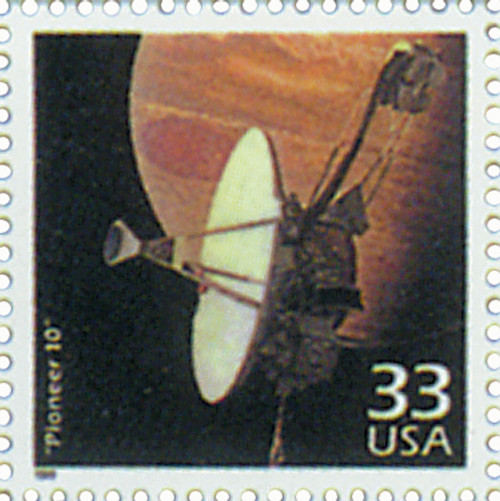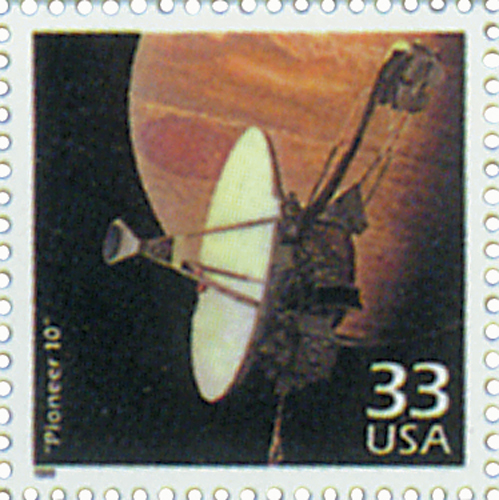
# 3189i FDC - 1999 33c Celebrate the Century - 1970s: "Pioneer 10"
1999 33¢ Pioneer 10
Printed By: Ashton-Potter
Printing Method: Offset Press
Pioneer 10 Is Launched

On March 2, 1972, Pioneer 10, the first spacecraft to leave our Solar System, was launched from Cape Canaveral, Florida.
The planning for Pioneer 10 first began in the 1960s, when Aerospace engineer Gary Flandro suggested a “Planetary Grand Tour.” The tour would take advantage of a rare alignment of the outer planets of our solar system. NASA developed a proposal for a pair of “Galactic Jupiter Probes” to pass through the asteroid belt and provide the first close-up pictures of Jupiter.
The proposal was approved in February 1969, and the two spacecraft, which later came to be known as Pioneer 10 and Pioneer 11, were built. They would become the first of several probes to explore the outer solar system. Over 150 scientific experiments were suggested for these missions. These included imaging Jupiter and moons, taking infrared and ultraviolet images, determining the makeup of charged particles, and measurement of the planetary atmosphere.

The first of the probes, Pioneer 10, was launched successfully on March 2, 1972, aboard an Atlas-Centaur launch vehicle. Pioneer 10 was the fastest man-made object at that time, passing the Moon only 11 hours later. Within 10 days all the scientific instruments aboard the probe were active and ready to report back data.
Along the journey to Jupiter, Pioneer 10 became the first probe to detect interplanetary helium atoms. And on July 15, 1972, it was the first spacecraft to enter the asteroid belt between Mars and Jupiter. During the eight months Pioneer 10 traveled through the belt, it found that most of the particles within it were smaller than a millimeter.
Pioneer 10 began approaching Jupiter on November 6, 1973. Early tests showed the planet’s magnetic field was inverted compared the Earth’s. On November 26, NASA scientists received the first close-range photos of Jupiter. Image quality improved in the coming days and by December 2, photos of Jupiter were shared with the public in real-time. This later earned the Pioneer program an Emmy award for its presentation to the media. During this time, over 500 images of Jupiter were sent back to Earth. As Pioneer 10 passed behind Jupiter, communication ceased, but infrared scanners showed that the planet radiated more heat than it received from the Sun.

After passing Jupiter, Pioneer 10 crossed Saturn’s orbit in 1976 and Uranus’ in 1979. After crossing Neptune in June 1983, Pioneer 10 became the first man-made object to go beyond the major planets of our solar system. The mission officially ended on March 31, 1997, when the probe reached a distance of 6.2 billion miles from the Sun, though it was still able to transmit data back to Earth. The probe’s signal grew weaker the farther it traveled, and the last discernible transmission was received on April 27, 2002. NASA continued to receive very weak signals for several months, with the last arriving on January 23, 2003.
Scientists estimate that Pioneer 10 is over 8 billion miles from Earth today. At the suggestion of Carl Sagan, both Pioneer 10 and 11 carry a gold-anodized aluminum plaque in case they are ever found by life forms from another planet. It includes male and female figures and symbols telling the origin of the probe. Click here to learn more about the plaque.
1999 33¢ Pioneer 10
Printed By: Ashton-Potter
Printing Method: Offset Press
Pioneer 10 Is Launched

On March 2, 1972, Pioneer 10, the first spacecraft to leave our Solar System, was launched from Cape Canaveral, Florida.
The planning for Pioneer 10 first began in the 1960s, when Aerospace engineer Gary Flandro suggested a “Planetary Grand Tour.” The tour would take advantage of a rare alignment of the outer planets of our solar system. NASA developed a proposal for a pair of “Galactic Jupiter Probes” to pass through the asteroid belt and provide the first close-up pictures of Jupiter.
The proposal was approved in February 1969, and the two spacecraft, which later came to be known as Pioneer 10 and Pioneer 11, were built. They would become the first of several probes to explore the outer solar system. Over 150 scientific experiments were suggested for these missions. These included imaging Jupiter and moons, taking infrared and ultraviolet images, determining the makeup of charged particles, and measurement of the planetary atmosphere.

The first of the probes, Pioneer 10, was launched successfully on March 2, 1972, aboard an Atlas-Centaur launch vehicle. Pioneer 10 was the fastest man-made object at that time, passing the Moon only 11 hours later. Within 10 days all the scientific instruments aboard the probe were active and ready to report back data.
Along the journey to Jupiter, Pioneer 10 became the first probe to detect interplanetary helium atoms. And on July 15, 1972, it was the first spacecraft to enter the asteroid belt between Mars and Jupiter. During the eight months Pioneer 10 traveled through the belt, it found that most of the particles within it were smaller than a millimeter.
Pioneer 10 began approaching Jupiter on November 6, 1973. Early tests showed the planet’s magnetic field was inverted compared the Earth’s. On November 26, NASA scientists received the first close-range photos of Jupiter. Image quality improved in the coming days and by December 2, photos of Jupiter were shared with the public in real-time. This later earned the Pioneer program an Emmy award for its presentation to the media. During this time, over 500 images of Jupiter were sent back to Earth. As Pioneer 10 passed behind Jupiter, communication ceased, but infrared scanners showed that the planet radiated more heat than it received from the Sun.

After passing Jupiter, Pioneer 10 crossed Saturn’s orbit in 1976 and Uranus’ in 1979. After crossing Neptune in June 1983, Pioneer 10 became the first man-made object to go beyond the major planets of our solar system. The mission officially ended on March 31, 1997, when the probe reached a distance of 6.2 billion miles from the Sun, though it was still able to transmit data back to Earth. The probe’s signal grew weaker the farther it traveled, and the last discernible transmission was received on April 27, 2002. NASA continued to receive very weak signals for several months, with the last arriving on January 23, 2003.
Scientists estimate that Pioneer 10 is over 8 billion miles from Earth today. At the suggestion of Carl Sagan, both Pioneer 10 and 11 carry a gold-anodized aluminum plaque in case they are ever found by life forms from another planet. It includes male and female figures and symbols telling the origin of the probe. Click here to learn more about the plaque.












